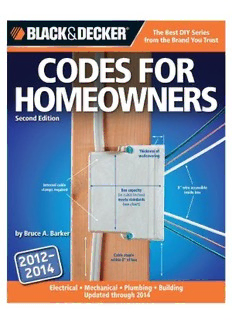
Black & Decker Codes for Homeowners PDF
Preview Black & Decker Codes for Homeowners
CODES FOR HOMEOWNERS Second Edition Your Photo Guide to: Electrical Codes • Plumbing Codes • Building Codes • Mechanical Codes by Bruce A. Barker Contents Introduction Codes & Permits: The Basics Building Design & Safety Habitable Rooms Fire Separations Stairways Emergency Escape Openings Egress Doors Exterior Doors Ventilation & Exhaust Smoke & Carbon Monoxide Alarms Clearances for Cooking Equipment Structural Components Foundations Crawlspaces Decks Floor Systems Wall Systems Wall Penetration Flashing Roof Systems Exterior Components Shingle Roof-Covering Installation Fireplaces & Chimneys Heating & Air Conditioning HVAC Appliances HVAC Duct Installation Combustion Air for Fuel-burning Appliances Vents for Fuel-burning Appliances Plumbing System The Home Plumbing System Water Supply Piping Drain, Waste & Vent Piping (DWV) Plumbing Vents Plumbing Traps Plumbing Appliances & Fixtures Electrical System Understanding Electrical Circuits Electrical Grounding & Bonding Electrical Branch Circuit Requirements Electrical Receptacle Installation Ground-fault (GFCI) & Arc-fault (AFCI) Protection Junction Boxes, Device Boxes & Enclosures Switch Installation Light Fixture Installation Satellite Dishes, Television & Radio Antennas Broadband Cable Wiring Appendix Conversion Chart Resources Photography Credits Index Introduction B uilding codes are adopted by governmental agencies to preserve your family’s safety as well as your fiscal well-being. Whether you are someone who likes to do your own home improvement and repair work, a homeowner acting as your own contractor, or anyone else who wants his or her work to conform to applicable building codes, this building code book is for you. Based largely on the 2012 version of the International Residential Code (IRC), it aims to make the most important wiring, plumbing, construction, and HVAC codes more accessible, simpler to navigate, and easier to understand so that you can interpret them effectively in your own home. The key to accomplishing the objective of making codes easier to understand is simple in concept but a little tricky to execute: do it right and take pictures. In this book you’ll find hundreds of professional quality images that depict code-compliant practices. No wading through page after page of incomprehensible jargon; no studying jumbles of lines and strange symbols to try and answer your question. Simply see for yourself. This book does not replace the IRC. It contains IRC provisions that have been selected to help you avoid common code violations, based on largely my years of experience as a professional building inspector. To avoid confusion and keep it simple, this book omits many highly technical IRC provisions and many provisions that you simply are unlikely to encounter. While every effort has been made to accurately present the recommended practices of the IRC with easy to understand language, pictures, and diagrams, this book is not the IRC. In a dispute, the wording in the IRC, as interpreted by the local building official, is the final authority on what IRC provisions mean. And, as we’ll discuss, local code provisions and interpretations always overrule code books such as this one. The intent of Codes for Homeowners is to serve as a reference that answers a host of questions that boil down to “What should it look like when I’m done?” You will not find a lot of material that describes the specific steps needed to get there—you’ll find many fine step-by-step instruction manuals that perform this part of the job. By studying this book and understanding its contents, you will arrive in the ballpark, metaphorically speaking, of IRC code compliance. But codes do not happen in a vacuum. As we discuss in subsequent sections, each local building department and each local building inspector has his or her own opinions about how building codes apply in their area. If you have any doubts or questions about how a building code provision applies in your area, you should ask the local building official. In almost every case, if you approach them as a resource and not as an obstacle, you will find your local inspectors to be friendly, knowledgeable, and eager to help. —Bruce A. Barker Residential Combination Inspector International Code Council Codes & Permits: The Basics I n just the United States you will find hundreds of code books describing thousands upon thousands of building code provisions. On top of this, there are even more books that look and feel like code books but are really only attempting to describe best practices. Almost all of these have their own inherent value. But almost none of them apply to a typical homeowner living in a typical single- family home. As a homeowner and DIYer, perhaps the hardest thing about building codes is learning how to tell which one applies to you and, if there is a disagreement, which takes precedence. As an introduction, here are some brief biographies of the more common codes and enforcement agencies you’re likely to encounter. The International Residential Code The International Residential Code (IRC) 2012 is one of an extensive collection of model building codes published by the International Code Council (ICC). A model building code is a recommended building code that is developed by a national organization that specializes in writing building codes. When adopted by a government agency, the IRC regulates the construction, renovation, maintenance, and repair of buildings used as homes. The IRC, by itself, has no formal legal status. A government agency must first adopt the IRC before it has any legal status in a local area.
